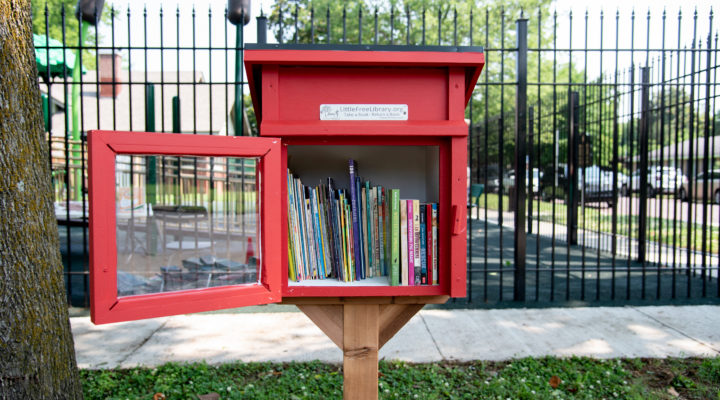The day finally arrived. Janee’ Jones Tisby and her 5th-grade class were en route to Memphis’ dazzling Pink Palace Museum. After months of hard work in the classroom, they would leave the Mississippi Delta behind and revel in a literal mansion full of the Mid-South’s rich cultural and natural history. The van was abuzz as it pulled through the roundabout, adorned with a centerpiece of ruby red tulips, and its passengers beheld the 84-year-old estate for the first time. The facade of pink Georgian marble sparkled in the morning sun, as if to announce the wonders inside, where visitors can witness the Canyon Diablo meteorite, count the vertebrae in a giraffe’s neck and meet Stan, the 40-foot Tyrannosaurus rex skeleton.
As Tisby’s class filed into the main lobby, Stan the T-Rex greeted them from atop the brass-plated escalator. Tisby stepped on the escalator to proceed upstairs to the first exhibit, but nobody followed. Pandemonium had enveloped the entire lobby behind her, and the commotion was coming from her students.
“What is going on?” Tisby begged from the second floor. “Let’s just go upstairs!”
Suddenly, it hit her. Her students had never seen or ridden an escalator before. Some were terrified. Some were beside themselves with glee. Most continued taking ride after ride, as Stan and his mansion of wonders took a backseat to the marvels of mechanical moving stairs.
“It seems small and silly,” Tisby explains. “But it’s a perfect illustration for the lack of opportunity that children in poverty face.”
“Telling 5th-graders in the Delta to imagine a better future is like telling them to imagine the ocean when the biggest body of water they’ve seen is a catfish pond or a river. You can take that analogy on and on. It’s so much harder for a child to say, ‘I want this’ or ‘I can do this’ when he or she can’t see it and it seems like it’s really far away. That escalator is really tiny, but it illustrates to me how difficult it can be for a kid to dream into what he or she actually wants, or even know what to dream in the first place.”
Tisby’s initial three years in the Mississippi Delta with Teach for America led to nine more in the region surrounding the Mississippi River – known by locals in both Mississippi and Arkansas simply as “the Delta.” In 2016 Tisby, her husband Jemar and son Jack settled in Helena, Arkansas, as the Cooperative Baptist Fellowship named her director of Together for Hope Arkansas, part of CBF’s nationwide rural development coalition. For the last two years, Tisby has been refining a nearly 20-year relationship with the Helena community and partner churches across the United States. Together, they continue to engage in asset-based development among Helena’s children and teenagers, who carry a 43-percent share of Helena’s poverty by age.
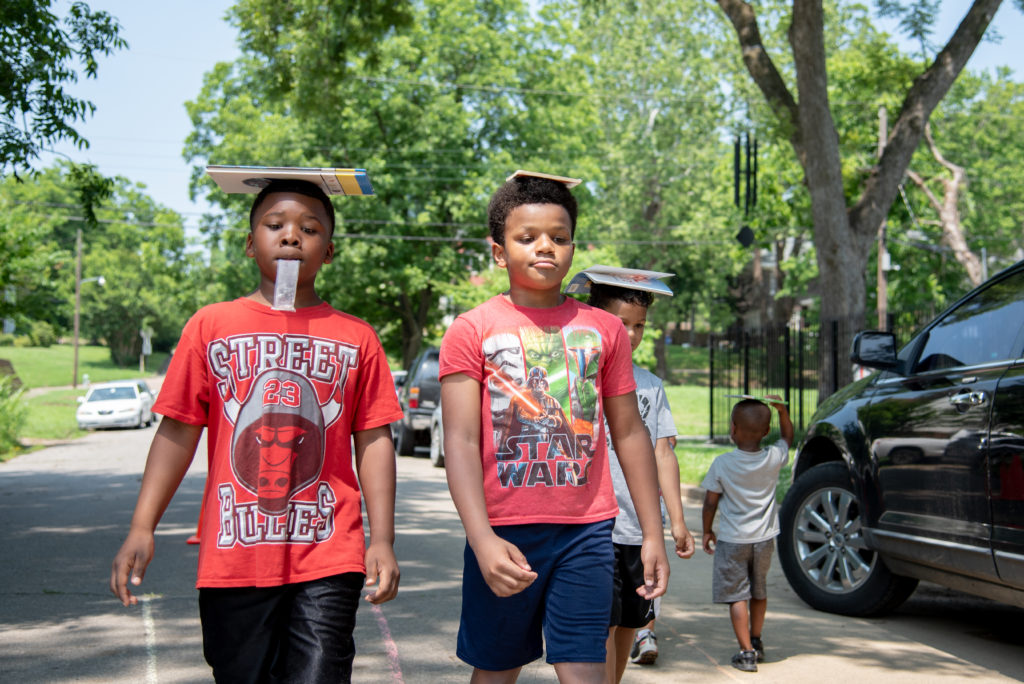
A relay race at the opening of Freeman Playground and the Free Little Library.
Whether in Mississippi or Arkansas, Tisby explains, developing the Delta’s youngest is ultimately about expanding their imagination for what lies beyond the limited view of poverty. Today, that view is obstructed by a host of systemic inequities in Helena, including a median household income of only $21,000, one the lowest in the country. What’s more, black and African-American residents, who comprise 76 percent of Helena’s population, experience 96 percent of its poverty. That leaves most of Helena’s children with limited or simply no access to predictable meals, health care, extracurricular activities and educational resources outside of school. While families rarely overcome poverty by sheer will, Tisby explains, it is infinitely more feasible to interrupt the cycle of generational poverty by empowering young people with education and imagination for a different future. At the end of the day, kids don’t recognize their own poverty, so how could they dream of more without first seeing it?
“Anytime it’s possible, we want to take kids outside of the Delta and show them something else,” Tisby says. “Whether it’s going to Memphis or Little Rock or even something smaller, like showing them Stringtown Farm or the Mississippi River – just showing them more. Even in a place like Helena, that doesn’t have a ton of museums or things like that, there are assets that we really try to explore.”
That said, if TFH spends a few days each year exposing Helena’s children to the wider world, it spends every other day bringing the wider world to Helena, Tisby says, and that begins with books. “You can dream into so much more by reading, and that’s why literacy is so important to us.”
For nearly two decades, TFH has been circulating children’s books throughout Phillips County through Stories on Wheels, an enormous yellow school bus furnished with 3,000 books, games, crafts and a reading area. In addition, Together for Hope pairs community volunteers with students in nearby Lake View, Elaine and Helena’s own Eliza Miller Elementary to provide tutoring and supplemental reading programs. Whether it’s Henry and Mudge books or the increasingly popular non-fiction genre, Tisby says, “seeing kids who could not stand to read but who are now just obsessed with books is amazing.”
Down at Helena’s Freeman Playground, last night’s storms have cleared and a hive of volunteers are preparing for the opening of Helena’s first “Free Little Library.” Misti and Will Staley, who moved from Brooklyn to Helena a few years ago, acquired a grant for the playground’s construction just north of the town square. In fact, the Staleys chose Helena in part because Will grew up volunteering with Together for Hope through his childhood church in Little Rock. Clamoring through an amplified megaphone, Misti calls for a handful of children to grab hold of the giant wooden scissors, as Will positions the red ribbon in front of the Free Little Library. He sneaks a pair of Fiskars from his pocket.
“Alright, help me count down from three,” Misti calls to the crowd. “Three, two, one, it’s officially open!”
With a quick snip of the ribbon, Helena’s first Free Little Library opens to children who can now retrieve and return books at their leisure from the oversized mailbox just off Market Street. It’s one more step in the slow work of building imagination, Tisby says, but the Staleys represent an asset even greater than mere books and playgrounds. Field trips and literacy are crucial in developing dreams, but they don’t live and breathe like Together for Hope’s 170 annual volunteers, who travel from states as far away as North Carolina just to spend a week with Helena’s children. Some have made the trip 18 years in a row.
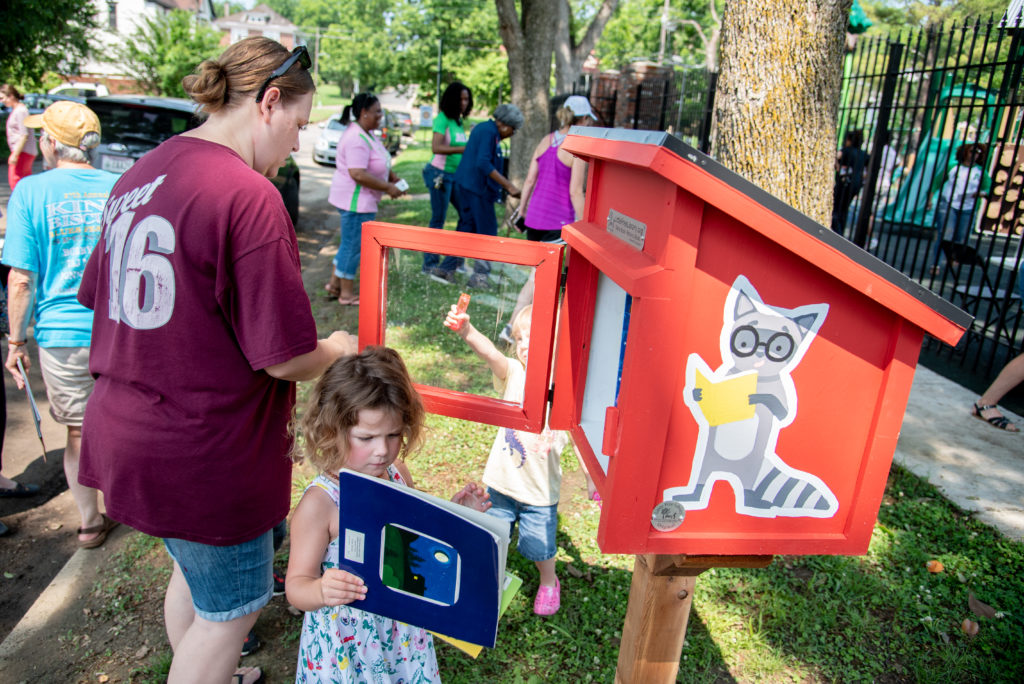
Helena’s children can take and leave books at their leisure from the Free Little Library on Market Street.
“One of the biggest things, and we particularly see this in the summertime during camp,” Tisby says, “is building a relationship with someone year after year who is from somewhere else, and hearing about that place and what they do – just being able to learn from folks is so extremely helpful in expanding horizons.”
Jaylen Randolph grew up participating in Together for Hope. More than the programs, he says, he was transformed by relationships with adult volunteers, who not only invested in his life but opened their own lives to him. Randolph was born in Helena, attended Central High School, and says he was none the wiser about his community being a “bad place.”
“Helena, for me, was always a safe haven and I used to never want to leave because it was always my comfortable place,” he says. As he grew older, however, he began to open his eyes to the reality of poverty and how it defeated so many of his friends and neighbors.
“Being in all of that ‘negative’ just made me want to be positive and try to help uplift my community and bring it back up,” he explains. “That’s my main mission. I want to go back home and help build my community back up because people are always talking about how Helena is this and that, but they don’t want to put in the work. That’s one thing I want to fix.”
Until then, Randolph is pursuing a biology and pre-medicine degree at the University of Arkansas at Pine Bluff and says Helena helped build the man he is today. Since age 9, Randolph could barely wait to attend TFH’s swim camp each year. He even snuck in at 13, past the normal age to attend but before he could become a volunteer. As soon as he turned 16, he immediately applied to be a group leader and mentor for younger campers throughout the summer. Soon, Randolph was accompanying tutoring teams to nearby Lake View and even volunteering after school at TFH’s offices at Delta Fellowship Church. What’s utterly baffling, he says, is that his most meaningful moments were spent with TFH’s mostly white volunteers from partner churches outside Helena.
“I’m gonna be real with you – I’ve never seen a group of people outside of my race and color love people that are my race and my color the way they do,” he says, suppressing a laugh. “Every time they come now, they’re so happy to see Helena and I never really understood why they love it so much until now.”
One Sunday morning, a volunteer team from Wilmington, North Carolina, was attending worship with Randolph’s home congregation, the New Hope Missionary Baptist Church, just across North Helena Park from the municipal swimming pool. As the worship service came to a close, the pastor stood at the front altar for his customary post-sermon call. “Bring someone up you don’t know,” the pastor implored. Jaylen knew exactly who to bring: Angie Graham, one of his favorite volunteers. As he escorted Graham to the front of the sanctuary and faced the congregation, he let out a gasp and yelled clear to the back wall.
“I love me some vanilla!”
Graham turned to Randolph and grabbed his hand. “I love me some chocolate!” she exclaimed, as the congregation erupted in laughter and applause.
“I’ll always remember that,” Randolph says through a smile, “and every time we see each other we always greet each other by saying that.” Now a junior at UAPB, Randolph is studying to become a pediatrician. He wants to make sure that the children of Phillips County, some of the most vulnerable in Arkansas, are healthy and safe as they develop. For the time being, Randolph will settle for volunteering yet again with Together for Hope during his summer break.
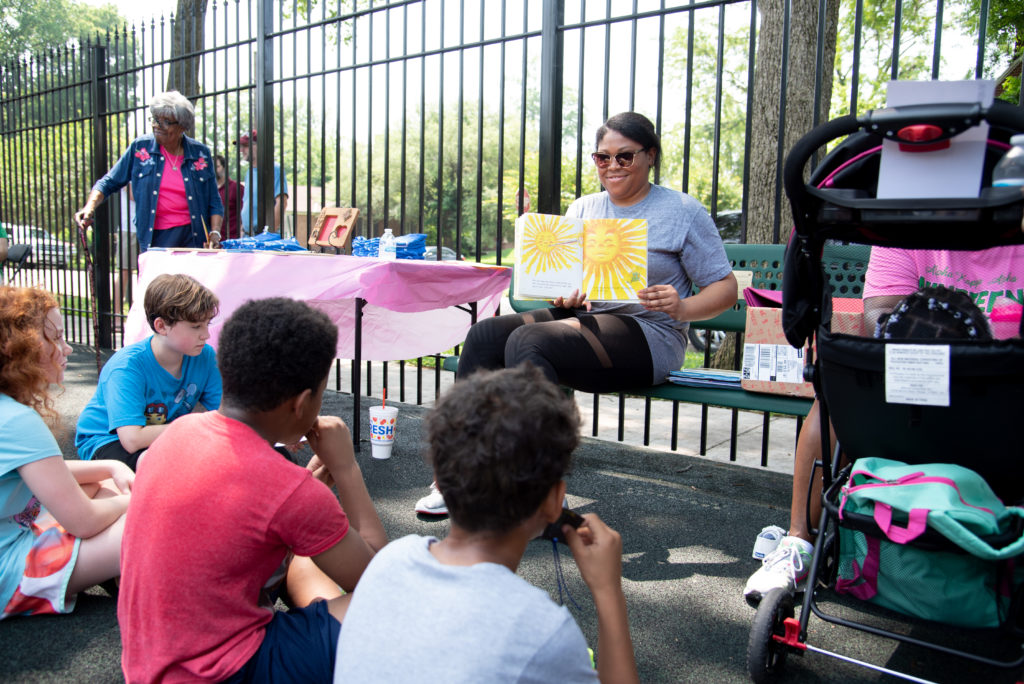
Together for Hope relies on more than 170 volunteers each year as they develop the imagination of Helena’s children.
Back in her office at Delta Fellowship Church, Janee’ Tisby prepares for Randolph and nearly 200 more volunteers to descend on their favorite home away from home this summer. Of course, not every child who engages with TFH will continue to college or even overcome the mindset that poverty often instills in their minds. “It’s really hard to see kids becoming more reserved and beginning to doubt their strengths, to doubt the positives they bring,” she explains. The goal, she continues, is to remain thoughtful and responsive to wherever a child is on his or her journey of imagination. Poverty will surely take its toll on a child’s confidence and vision for a bigger future, even on his or her ability to make small strides along the way.
But ultimately, Tisby says, setting high expectations is absolutely crucial for children growing up in poverty. “Our kids need to know that we believe they can achieve, that we believe they can do what they need to function, in a classroom or wherever.”
“At the same time, it’s also important for them to know that we will partner with you and help you get there, and what you need may be different from what someone else needs or even most kids need, and that’s okay. But when they see that we doubt it, they lower their expectations for themselves. So we want to make sure we have really high expectations because they really can reach them.”
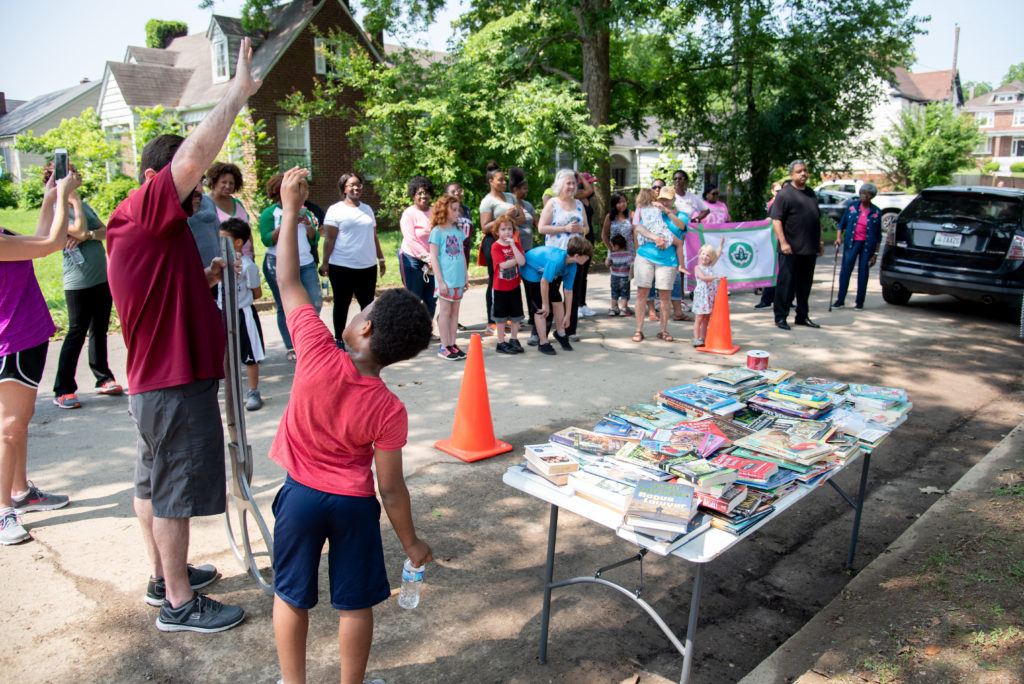
As they collaborate, Helena’s mostly black community and Together for Hope’s largely white volunteer base speak often of the uncommon trust between them.
Read more in the Arkansas Delta series:
At the center of Helena, Arkansas’s fight against poverty and division: an 85-year-old swimming pool
Imagination is the greatest threat to Delta poverty, Together for Hope Arkansas says
Phillips County, Arkansas: Backwater Rising
Video: Janee’ Tisby on Volunteers
Video: Janee’ Tisby on Poverty
Video: Earnest Womack on the Pool
Video: Earnest Womack on Poverty
Related commentary at baptistnews.com:
Survival mode | Jason Coker
Reimagining churches as full-time partners with those in poverty | Laura Rector
Related news at baptistnews.com:
Hope blooms in the Arkansas Delta, thanks to ministry team
Like the rising river of the Arkansas Delta, the persistence of poverty still looms just over the levee, threatening to wash young people down paths of violence, drugs, food insecurity, unemployment, and early death. That’s why Together for Hope is committed to growing the gifts and dreams of Helena’s children as they seek to interrupt cycles of generational poverty and instill lasting hope in the Delta’s youngest.
This series in the “Resilient Rural America” project is part of the BNG Storytelling Projects Initiative. Has the United States forgotten its countryside? What strength and resilience may yet be stirring outside our city limits? In “Resilient Rural America,” we attempt to answer these questions when we visit these unique communities to examine the singular nature of poverty in rural America and tell the stories of development among its courageous and resilient people.
_____________
Seed money to launch our Storytelling Projects initiative and our initial series of projects has been provided through generous grants from the Christ Is Our Salvation Foundation and the Eula Mae and John Baugh Foundation. For information about underwriting opportunities for Storytelling Projects, contact David Wilkinson, BNG’s executive director and publisher, at [email protected] or 336.865.2688.

